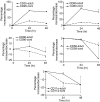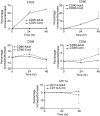Potential immaturity of the T-cell and antigen-presenting cell interaction in cord blood with particular emphasis on the CD40-CD40 ligand costimulatory pathway
- PMID: 15312133
- PMCID: PMC1782544
- DOI: 10.1111/j.1365-2567.2004.01933.x
Potential immaturity of the T-cell and antigen-presenting cell interaction in cord blood with particular emphasis on the CD40-CD40 ligand costimulatory pathway
Abstract
There are reports of immaturity of the neonatal immune system, which may explain the low incidence of graft-versus-host-disease (GVHD) after cord blood transplantation. The CD40 ligand (CD40L)-CD40 interaction is important in regulating the cellular immune response. We hypothesized that the neonatal immune system may show immaturity in this interaction. We studied the function of the CD40L-CD40 interaction in the T-cell interaction with B cells and monocytes in cord blood compared with adult blood in vitro. Consistent with previous reports, CD4+ T cells do not express CD40L after T-cell activation. In whole blood, adult monocytes, but not neonatal monocytes, were activated following T-cell activation. However, the activation of adult monocytes was not dependent on the CD40L-CD40 interaction. Using the CD40L trimer (Lt), we showed that cord B cells have comparable responses to CD40 ligation to those of the adult B cells. Both cord and adult monocytes do not respond as well as B cells and this is probably related to low density of expression of CD40. However, interferon-gamma up-regulated CD40 on adult monocytes but not on cord monocytes. This potentiated the adult monocyte response to CD40 ligation by CD40Lt. Our findings suggest that the neonatal CD40L-CD40 pair is immature in the cellular immune response involving monocytes and that interferon-gamma fails to activate neonatal monocytes for a response to CD40L. These findings suggest that in the inflammatory microenvironment of cord blood transplantation neonatal monocytes may play a minor role in the effector arm of the immune response. This finding may be one of several mechanisms for the low incidence of GVHD that is observed following cord blood transplantation. Also the ligand-receptor immaturity may contribute to the increased susceptibility of newborns to certain infections.
Figures





Similar articles
-
Undetectable CD40 ligand expression on T cells and low B cell responses to CD40 binding agonists in human newborns.J Immunol. 1995 Feb 15;154(4):1560-8. J Immunol. 1995. PMID: 7530739
-
CD40 ligand induction on T cell subsets by peptide-presenting B cells: implications for development of the primary T and B cell response.J Immunol. 1997 Sep 1;159(5):2282-91. J Immunol. 1997. PMID: 9278317
-
CD40-CD40 ligand interaction is central to cell-mediated immunity against Toxoplasma gondii: patients with hyper IgM syndrome have a defective type 1 immune response that can be restored by soluble CD40 ligand trimer.J Immunol. 1999 Jun 1;162(11):6690-700. J Immunol. 1999. PMID: 10352287
-
CD40 ligand-CD40 interaction in Ig isotype switching in mature and immature human B cells.Semin Immunol. 1994 Oct;6(5):295-301. doi: 10.1006/smim.1994.1038. Semin Immunol. 1994. PMID: 7532459 Review.
-
CD40 and its ligand in the regulation of humoral immunity.Semin Immunol. 1994 Oct;6(5):279-86. doi: 10.1006/smim.1994.1036. Semin Immunol. 1994. PMID: 7532458 Review.
Cited by
-
Challenges in vaccination of neonates, infants and young children.Vaccine. 2014 Jun 30;32(31):3886-94. doi: 10.1016/j.vaccine.2014.05.008. Epub 2014 May 14. Vaccine. 2014. PMID: 24837502 Free PMC article. Review.
-
Functional Heterogeneity of Umbilical Cord Blood Monocyte-Derived Dendritic Cells.J Immunol. 2024 Jul 15;213(2):115-124. doi: 10.4049/jimmunol.2400036. J Immunol. 2024. PMID: 38809115 Free PMC article.
-
Neonatal innate immunity to infectious agents.Infect Immun. 2006 Apr;74(4):1999-2006. doi: 10.1128/IAI.74.4.1999-2006.2006. Infect Immun. 2006. PMID: 16552028 Free PMC article. Review. No abstract available.
-
Whole Blood Profiling of Bacillus Calmette-Guérin-Induced Trained Innate Immunity in Infants Identifies Epidermal Growth Factor, IL-6, Platelet-Derived Growth Factor-AB/BB, and Natural Killer Cell Activation.Front Immunol. 2017 Jun 6;8:644. doi: 10.3389/fimmu.2017.00644. eCollection 2017. Front Immunol. 2017. PMID: 28634479 Free PMC article.
-
Neonatal regulatory T cells have reduced capacity to suppress dendritic cell function.Eur J Immunol. 2015 Sep;45(9):2582-92. doi: 10.1002/eji.201445371. Epub 2015 Jun 25. Eur J Immunol. 2015. PMID: 26046326 Free PMC article.
References
-
- Linsley PS, Ledbetter JA. The role of the CD28 receptor during T cell responses to antigen. Annu Rev Immunol. 1993;11:191–212. - PubMed
-
- Bachmann MF, McKall-Faienza K, Schmits R, et al. Distinct roles for LFA-1 and CD58 during activation of naïve T cells: adhesion versus costimulation. Immunity. 1997;7:549–7. - PubMed
-
- Dustin ML, Cooper JA. The immunological synapse and the actin cytoskeleton: molecular hardware for T cell signalling. Nat Immunol. 2000;1:23–9. - PubMed
-
- Hollenbaugh D, Ochs HD, Noelle RJ, Ledbetter JA, Aruffo A. The role of CD40 and its ligand in the regulation of the immune response. Immunol Rev. 1994;138:23–37. - PubMed
MeSH terms
Substances
LinkOut - more resources
Full Text Sources
Research Materials
